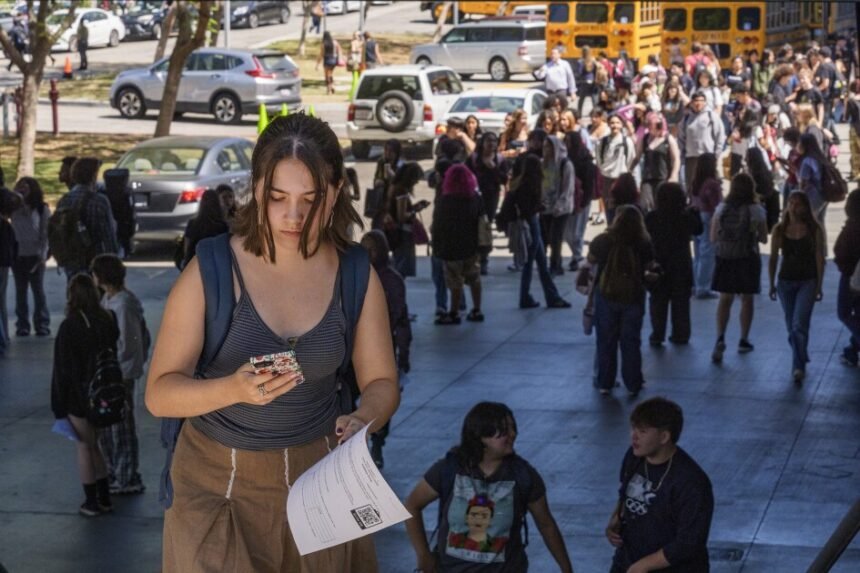States are banning cellphones in schools, but do these policies actually work to improve student behavior and achievement? A pair of research projects led by noted academic scholars provide some preliminary answers.
Among them: Stricter school cellphone policies lead to more focused classroom environments, according to survey results collected from 20,000 public school teachers from across the country.
And, in Florida, which in 2023 became the first state to enact a statewide law restricting cellphones in schools, student test scores and attendance in one district have improved in the second year of the ban. However, researchers also found a significant increase in student suspensions in the short term, particularly among Black students.
Despite there being a wave of new state laws restricting students’ cellphone use in schools, there has been little rigorous research so far into the effectiveness of these policies on student academics and behavior—or on teachers’ job satisfaction.
Now, researchers are trying to bring critical insights that will inform those decisions, said Angela Duckworth, a psychology professor at the University of Pennsylvania who is helping guide a study of the impact of cellphone policies.
“When we did a landscape analysis of the scientific evidence on which policies are best, we found it sorely lacking,” Duckworth said. “Policies are happening. They have to be informed” by research.
At least 31 states and the District of Columbia require school districts to ban or restrict cellphones, according to an Education Week tally. (Additional states either incentivize or recommend local districts enact their own policies.) Of those states that restrict cellphones, 22 have a so-called bell-to-bell ban, which means students aren’t allowed to use their smartphones for the entire school day.
An additional eight states ban cellphones during instructional time, and two have not specified when phones should be prohibited. While a handful of states set a single, statewide policy, most require districts to create their own policies restricting cellphones.
What if bell-to-bell smartphone bans aren’t enough?
Many school cellphone policies focus on the part of the school day students can’t have their phones, not on how they’re stored.
But smartphone storage, from the standpoint of human behavior, is an important consideration for crafting meaningful cellphone policies, said Duckworth, known for her research and writing on the connection between achievement and resilience.
Duckworth is leading an effort along with economists from Stanford University to survey 100,000 public school teachers by the end of the year. Their preliminary findings from 20,000 teachers found that the most common storage requirement is a “no-show” policy, which allows students to keep their phones in their pockets or backpacks, so long as they are out of sight.
Nearly half of schools in the survey sample have that type of policy.
Based on the preliminary data, policies that require students to store their phones in pouches or lockers are linked to more focused classrooms, according to teachers, said Duckworth, as are bell-to-bell policies.
“In psychology, there is a principle that could be summarized as physical distance creates psychological distance,” Duckworth said. “When you are in the presence of a temptation, the closer it is to you, the more tempting it is.”
In other words, a cellphone buzzing in a back pocket or in a backpack at a student’s foot is more distracting than a cellphone locked in the front office, Duckworth said.
All-day cellphone bans are most common in elementary and middle school, the researchers found. Among high school teachers, 1 in 4 reported that cellphones were banned throughout the entire school day, while 3 in 4 elementary and middle school teachers reported their school having a bell-to-bell ban.
The research project, called Phones in Focus, will release additional results from the larger, 100,000-teacher sample in the new year. (Educators can take the survey here.) Eventually, the researchers plan to explore whether and how different cellphone policies affect objective data like test scores and attendance, Duckworth said.
Florida’s cellphone ban shows improvement in test scores and attendance
Another analysis that has not yet gone through the peer review process found both promising and cautionary early results in Florida schools following their implementation of the statewide cellphone ban.
The study, which drew on data from a large urban county-level school district, was led by David Figlio, an economics professor at the University of Rochester, and Umut Özek, an economist with the RAND Corp., a nonprofit research organization.
The research looks at how students’ scores on state standardized tests, and their attendance, changed after the ban, by comparing schools where students used their cellphones a lot during the day to schools where students used their cellphones less. The study design is meant to ensure that the ban is causing the change in test scores and that it’s not just correlation.
Data on building-level cellphone activity was compiled by the company Advan, which tracks foot traffic for businesses. Achievement data came from the state’s FAST assessments in math and English-language arts, exams that are administered three times a year to elementary through high school students.
The study finds bigger gains in test scores in the schools that had higher rates of cellphone usage before the law went into effect, suggesting the restrictions had an effect, albeit a modest one, of .6 percentile point overall. The change is slightly larger, 1.1 percentile points, when comparing just the final test scores from spring 2025 to the year before the ban went into effect.
The effect is larger for male students (1.4 percentile points), white students (1.4 percentile points), middle and high school students (1.3 percentile points), and Black students (1.2 percentile points) comparing, again, only test scores from spring 2023 to spring 2025.
The ban also improved middle and high school students’ attendance, in particular unexcused absences, which likely helped improve the test scores, the study notes.
“One major argument behind cellphone bans is that it should lead to improved classroom environments,” Figlio said. “We can’t measure the classroom environment, but we can at least measure whether or not kids seem to want to be there. What we see is a pretty reasonably substantial reduction in the rate of unexcused absences.”
Suspensions soared during the first year of the cell phone ban
However, in the first year of the ban, school suspensions climbed as much as 12%, disproportionately affecting Black students. They mostly fell in the second year back to pre-ban levels, but this initial spike in suspensions should give policymakers and education leaders pause, said Figlio. (Nationally, Black students are generally disciplined at higher rates than their peers.)
Although this study doesn’t examine what specific aspects of the cellphone policy may have led to the higher initial rates of suspensions, Figlio has a couple of ideas.
First, students were still allowed to keep their cellphones in their back pocket or in a backpack during the day. Not removing the device entirely from students’ possession may have allowed for distraction, which in turn created conditions for disciplinary actions, the researcher said.
Second, the new rules and disciplinary measures may have been enacted too quickly, and students didn’t have time to adjust, Figlio said. A policy that provides a grace period and a slower ramp up of discipline might lead to fewer suspensions.
“What is going to be important for school districts, states, [and] countries, introducing these cellphone bans would be to recognize that if you have a ban, there’s gonna be enforcement,” the researcher said.
“This could lead to deleterious outcomes that we don’t necessarily want. What can we do to either reduce the need for the enforcement or to be a bit more generous in the rollout of the policy?”







